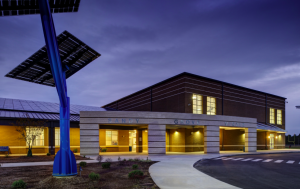
Sandy Grove Middle School in Hoke County, N.C., was designed to be an energy-positive building. It generates 40 percent more energy than it consumes. Photo: Mathew Carbone Photography
When Robbie Ferris first presented the idea of a school building that generates more energy than it uses, people were skeptical. Now he can point to Sandy Grove Middle School in Hoke County, N.C., as proof that a high-performance school building can go well beyond net zero and generate 40 percent more energy than it consumes.
Ferris is the president of SfL+a Architects and manager at Firstfloor, a development company that specializes in public-private partnerships and design-build-operate agreements. “We designed the building, we own it and we lease it to the school district,” he says. “We monitor all of the systems remotely. One of the reasons we do that is because when you put really high-performance systems in buildings, you have to make sure they are operating at peak efficiency. It can take time to make sure everything is optimized.”
Three years after completion, Sandy Grove Middle School is outperforming its energy models, and the building continues to win accolades. It recently received Energy Star 100 Certification and has been recognized as the nation’s most energy positive school.
“Sandy Grove Middle School is a perfect example of a high-performance facility,” says Ferris. “With the public-private lease-back model, everyone wins. The students receive a quality school, it fits in to the school system budget, and it is energy efficient to help both total cost and our environment.”
The building’s systems were designed to be as energy-efficient as possible, and that includes the roof, which features an array of photovoltaic (PV) panels to generate electricity. “We wanted a roof that would last 30 years,” Ferris notes. “We’ve had a tremendous amount of success with TPOs, and metal roofs as well. This particular client wanted a metal roof look from the front, but they were very open to a membrane roof on other parts of the building. We made the decision to put the metal roof on the front of the building and a TPO on the wings at the back of the building.”
On this project, the warranties were important considerations, along with durability and energy efficiency. SfL+a specified a standing seam metal roof system manufactured by Dimensional Metals Inc. and a TPO system manufactured by GenFlex. “Obviously, if you’re putting a couple of million dollars’ worth of solar panels on your roof, you want to make sure you have a roof that is going to be problem free.”
A Smooth Installation
The installation was a challenging one, but everything went smoothly, notes Aaron Thomas, president and CEO of Metcon Inc. Headquartered in Pembroke, N.C., Metcon is a full-service general contractor that specializes in energy positive commercial buildings, so it was perfectly suited to serve as the construction manager on the project.
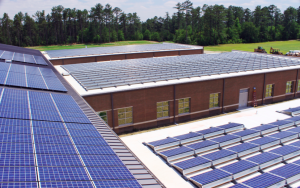
Photovoltaic panels were installed on both the standing seam metal roof and the TPO system. The systems on the low-slope roof sections are fully ballasted, and both sections were installed without penetrating the roof system. Photo: SfL+a Architects
Thomas and Ryan Parker, senior project manager with Metcon, coordinated the work of subcontractors on the job, including the Youngsville, N.C. branch of Eastern Corp., which installed the TPO and metal roofs, and PowerSecure, the solar installer on the project, based in Wake Forest, N.C.
The roof systems covered 85,000 square feet, and Sharp PV panels were installed on both the metal roof and the TPO system. Solar panels were also installed on freestanding structures called “solar trees.” Each solar tree is 20 feet tall, 25 feet wide and weighs 3,200 pounds.
“The TPO roof system was upgraded to an 80-mil product due to solar panels being added to the roof,” Parker notes. “It was 100 percent ballasted on the low-slope sections, with slip sheets being used below the racking on the TPO roof.”
On the metal roof, clips manufactured by S-5! were used to affix the solar racking to the seams. “There are no penetrations for the frames, and penetrations for the electrical wiring went through vertical walls, not the roof,” Parker says. “There were no penetrations anywhere in the roof system, which made all of the warranties that much easier to keep intact.”
The biggest challenges on the project, according to Parker, were coordinating the different scopes of work and ensuring all of the manufacturers’ warranty considerations were met. “We had two different kinds of roofs, both coupled with solar panels,” Parker says. “Like any rooftop with photovoltaic products, there had to be special attention paid to the warranties of all parties involved. Both Genflex and DMI were closely involved in coordinating details to ensure that the owner achieved a great roof free of defects.”
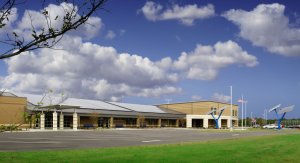
The building’s systems were designed for energy efficiency, and the roof features an array of photovoltaic panels to generate electricity. Photo: Mathew Carbone Photography
One key was developing a detailed schedule and keeping everyone on it. “We would meet once a week and huddle up on how it was progressing and what else needed to be done,” Parker recalls. “We found that by using a collaborative submittal sharing platform, all of the varying parts and pieces could be checked by all parties to ensure compatibility.”
There were multiple safety concerns associated with combining solar panels to the roofing system, so everyone had to be on the same page. “The roofing subcontractor and the solar subcontractor performed a joint safety plan that utilized common tie off points,” Parker notes. “The job had zero lost time.”
“Everyone coordinated their work and it was a great team effort,” Ferris says. “It was one of the smoothest jobs I’ve ever seen. We have not had a single leak on that project—not a single problem.”
Proof Positive
For Ferris, the greatest obstacle on energy-positive projects convincing members of the public and governmental agencies of the benefits. “The biggest challenges had nothing to do with construction; they had to do with just doing something new and different,” he says. “The toughest challenge was getting the school board, the county commissioners, the public and the review agencies on board. It took a very long time—and lots of meetings.”
Now Ferris can point to Sandy Grove as an example of just how a high-performance school building can pay huge dividends. “As soon as you see it in real life, you’re on board,” he says. “It’s very exciting for people to see it. If we can get people to the school, they’ll walk away convinced it is the right thing to do.”
With Sandy Grove, the school district has a 30-year lease with an option to purchase. Ferris believes the lease model is the perfect solution for educators. “We’re responsible for any problems for the life of the lease,” he says. “If a problem does come up, we usually know about it before the school does because we monitor the systems remotely online.”
“In their world, buildings are a distraction from educating kids,” Ferris concludes. “This is one building that is not a distraction.”
TEAM
Building Owner: Firstfloor, Inc., Winston-Salem, N.C., Firstfloor.biz
Architect: SfL+a Architects, Raleigh, N.C., Sfla.biz
Construction Manager: Metcon Inc., Pembroke, N.C., Metconus.com
Roofing Contractor: Eastern Corp., Youngsville, N.C.
Photovoltaic Panel Installer: PowerSecure, Wake Forest, N.C., Powersecure.com
Metal Roof System Manufacturer: Dimensional Metals Inc., DMImetals.com
TPO Roof System Manufacturer: GenFlex Roofing Systems, GenFlex.com

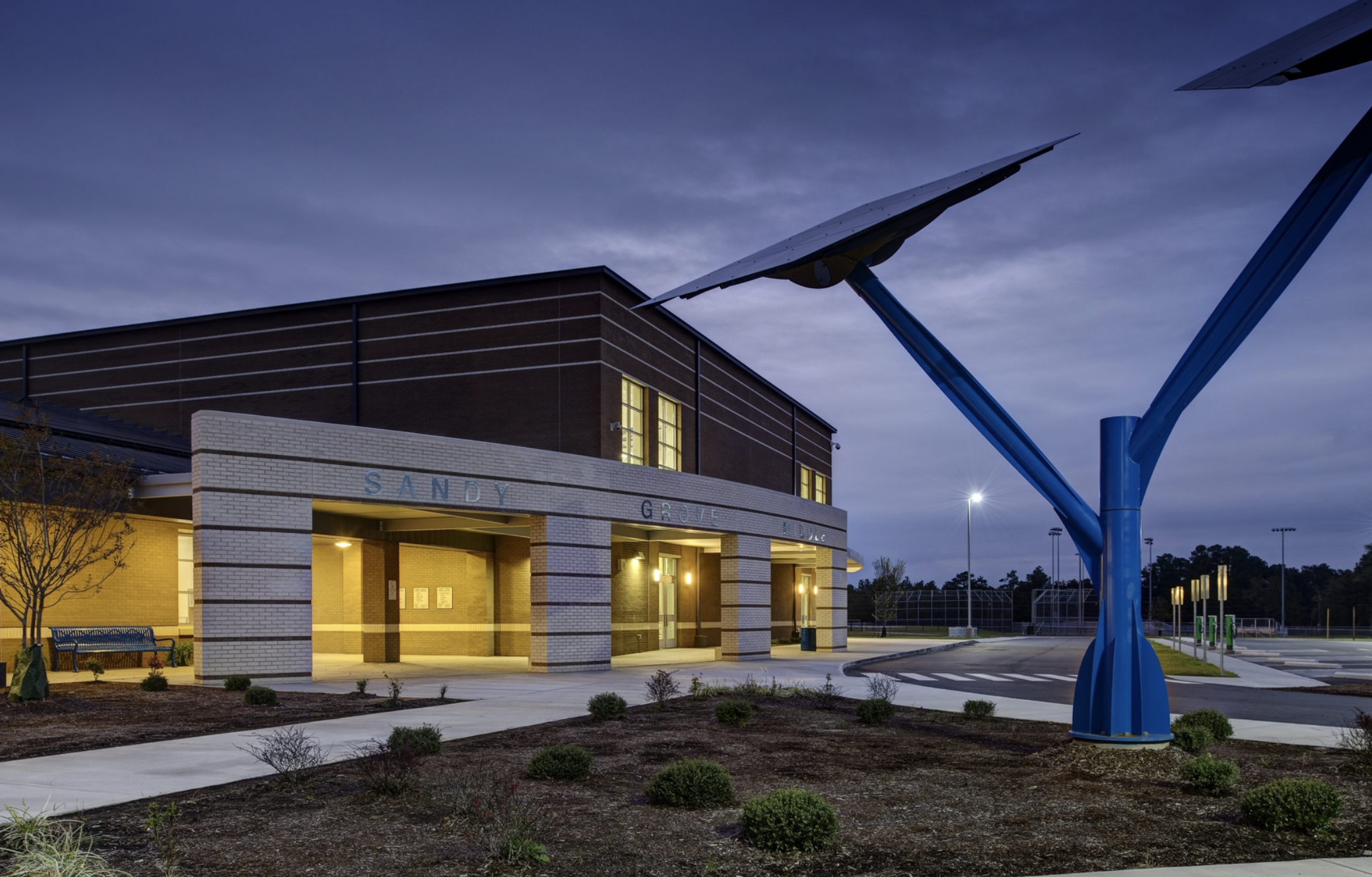
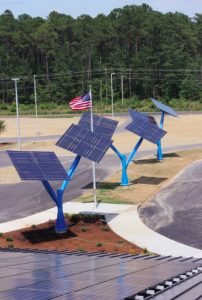



Be the first to comment on "North Carolina Middle School Generates More Energy Than It Uses"